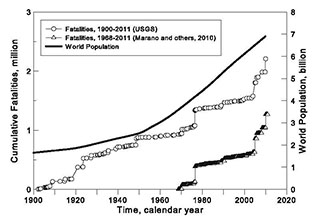Seismo Blog
Deadliest Decade on Record
Categories:
April 15, 2013

Following the same trend: The growing world population (solid line) and the number of people who died as a consequence of earthquakes from two different catalogs (From Holzer and Savage, 2013). (Click to view larger image.)
Sometimes seismologists are --the blogger is afraid to say -- a morbid bunch. When they gather around a computer screen or an old fashioned helicorder to observe incoming seismic waves of a strong earthquake in real-time, they often marvel at the beauty of the signals. In such cases they have to be reminded, that in a far corner of the world hundreds of people may have just lost their livelihood or even their lives in the destruction which this "beautiful" earthquake has caused. Of course, no seismologist wants to see people suffer because of earthquakes and many use their scientific and technical skills to help reduce the seismic risk. This job however is becoming more and more difficult, because the world population is growing rapidly and many megacities are located in seismically active zones or at coastlines prone to be hit by tsunamis.
The mortality due to earthquakes and their after effects seems to have been extremely high during the first decade of this century. Nobody will have forgotten the earthquake in Haiti in 2010, in which at least 220,000 people were killed despite its moderate magnitude of 7.0. (Seismo Blog: Extreme Damage That Didn't Have to Be). A similar number of people vanished in the tsunami, which swept across the Indian Ocean after the magnitude 9.3 Sumatra-Andaman earthquake in late December 2004. Earthquakes in the Pakistani area of Kashmir in 2005 and in the Chinese province of Sichuan in 2008 killed more than 80,000 each (Seismo Blog: Today in Earthquake History: Sichuan 2008). All told, close to 700,000 people died as a consequence of earthquakes from 2001 through 2010 alone, making it one of the seismically deadliest decades ever.
Because two colleagues from the USGS in Menlo Park, Tom Holzer and James Savage, were intrigued by this tragic record, they looked at long term trends in seismic mortality in the world. They analyzed the entries in several independent earthquake catalogs, which list the number of fatalities associated with seismic events. After running these data through various statistical algorithms and taking the growth of the world population into account, Holzer and Savage project a dim future. As they report in the latest issue of the technical journal "Earthquake Spectra" (Vol. 29, pg. 155), the number of deadly earthquakes will rise sharply during this century. Compared to the 20th century, the number of earthquakes with more than 50,000 fatalities will almost triple to about 20. The number of megaquakes with 100,000 or more fatalities will double to about nine. According to their projections, Holzer and Savage estimate that worldwide between 2.5 and 3.5 million people will perish in earthquakes and tsunamis during this century. (hra086)
BSL Blogging Team: Who we are
Recent Posts
-
: Alerts for the Whole West Coast
-
: Destruction in the Eastern Aegean Sea
-
: An Explosion in Beirut heard all over the Middle East
View Posts By Location
Categories
- Alaska (3)
- Bay Area (24)
- Buildings (3)
- Calaveras (4)
- California (13)
- California ShakeOut (3)
- Central California (4)
- Chile (4)
- Earthquake Early Warning (10)
- Earthquake Faults and Faulting (44)
- Earthquake Science (3)
- Haiti (3)
- Hayward (12)
- Indonesia (4)
- Induced Seismicity (3)
- Instrumentation (18)
- Italy (6)
- Japan (7)
- MOBB (3)
- Mendocino Triple Junction (5)
- Mexico (7)
- Nepal (3)
- North Korea (5)
- Nuclear Test (5)
- Ocean Bottom Seismometer (3)
- Oklahoma (4)
- Plate Tectonics (18)
- Preparedness, Risks, and Hazards (16)
- Salton Sea (3)
- San Andreas Fault (14)
- Seismic Waves (13)
- Seismograms (4)
- ShakeAlert (3)
- Southern California (5)
- Surface Waves (3)
- Today in Earthquake History (20)
- Volcanoes (4)
- subduction (3)